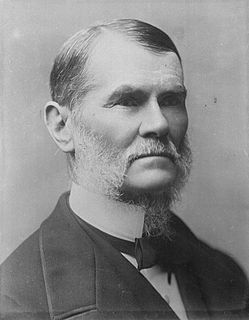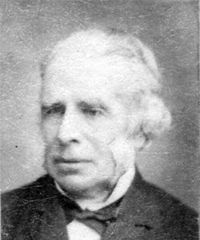Related Research Articles

William Forster was a pastoral squatter, colonial British politician, Premier of New South Wales from 27 October 1859 to 9 March 1860, and poet.
Illawarra was an electoral district of the Legislative Assembly in the Australian state of New South Wales. It was originally created in 1859, replacing East Camden. It was replaced by Wollongong in 1904 and recreated in 1927. In 1968, it was abolished and partly replaced by Kembla. In 1971, Kembla was abolished and Illawarra was recreated. In 2007, it was abolished and replaced by Shellharbour.
Robert Barbour was an Australian politician, merchant and squatter.

Bourke was an electoral district of the Legislative Assembly in the Australian state of New South Wales from 1880 to 1904, including the towns of Bourke and Cobar. It elected two members simultaneously between 1882 and 1889 increasing to three members until 1894, with each elector being able to vote for as many candidates as there were vacancies.

Cootamundra is an electoral district of the Legislative Assembly in the Australian state of New South Wales.
Gundagai was an electoral district of the Legislative Assembly in the Australian state of New South Wales from 1880 to 1904 in the Gundagai area. It was replaced by Wynyard.
Hastings was an electoral district of the Legislative Assembly in the Australian state of New South Wales from 1859 to 1880. It was abolished in 1880 as part of the first major redistribution since 1858, replaced by Hastings and Manning from 1880 to 1894, which elected two members with voters casting two votes and the two leading candidates being elected. In 1894 it was divided between the single-member electoral district of Hastings and Macleay and Manning. In 1920 proportional representation was introduced and Hastings and Macleay was absorbed into the new four-member district of Oxley. The electorate was named after the Hastings, the alluvial valleys of which contained most of its population.
William Love (1810-1885) was a member of the New South Wales Legislative Assembly for West Sydney from 1860 to 1864. Love served as Chairman of the Sydney Revenues Improvement Bill Committee.
Members of the New South Wales Legislative Assembly who served in the 10th parliament of New South Wales held their seats from 1880 to 1882.</ref> Elections for the tenth Legislative Assembly were held between 17 November and 10 December 1880 with parliament first meeting on 15 December 1880. Electoral reforms passed by the ninth parliament had resulted in parliament being expanded to 108 members elected in 43 single member electorates, 25 two member electorates, 1 three member electorate and 3 four member electorates. In addition, electorates franchised on qualifications of occupation or education had been abolished. The parliament had a maximum term of 3 years but was dissolved after 23 months. Sir Henry Parkes continued as the Premier for the duration of the parliament. The Speaker was Sir George Allen.
Members of the New South Wales Legislative Assembly who served in the 11th parliament of New South Wales held their seats from 1882 to 1885.</ref> Elections for the eleventh Legislative Assembly were held between 30 November and 21 December 1882 with parliament first meeting on 3 January 1883. The Assembly was expanded to 113 members elected in 40 single member electorates, 26 two member electorates, 3 three member electorate and 3 four member electorates. The parliament had a maximum term of 3 years and was dissolved on 7 October 1885 after 33 months. The Premiers during this parliament were Sir Alexander Stuart until 7 October 1885 and then George Dibbs. The Speaker was Edmund Barton.

William Adams Brodribb was an Australian pastoralist and politician.
Cootamundra, an electoral district of the Legislative Assembly in the Australian state of New South Wales, was created in 1904 and was abolished in 1941, returning one member until 1920, three members from 1920 to 1927 and one member from 1927 to 1941. It was recreated in 2015.
Newtown, an electoral district of the Legislative Assembly in the Australian state of New South Wales, was established in 1859.
Henry Edward Kater was an Australian politician.
The 1882 New South Wales colonial election was for 113 members representing 72 electoral districts. The election was conducted on the basis of a simple majority or first-past-the-post voting system. In this election there were 32 multi-member districts returning 73 members and 40 single member districts. In the multi-member districts each elector could vote for as many candidates as there were vacancies. 13 districts were uncontested. There was no recognisable party structure at this election. The average number of enrolled voters per seat was 1,701, ranging from East Maitland (984) to Wentworth (2,977).
The 1880 New South Wales colonial election was for 108 members representing 72 electoral districts. The election was conducted on the basis of a simple majority or first-past-the-post voting system. In this election there were 29 multi-member districts returning 68 members and 43 single member districts. In the multi-member districts each elector could vote for as many candidates as there were vacancies. 14 districts were uncontested. There was no recognisable party structure at this election. The average number of enrolled voters per seat was 1,549 for a country seat and 2,361 for an urban one, ranging from East Maitland (966) to Bourke (3,478).
East Macquarie, an electoral district of the Legislative Assembly in the Australian state of New South Wales was created in 1859 and abolished in 1894.
The Hastings, an electoral district of the Legislative Assembly in the Australian state of New South Wales was created in 1859 and abolished in 1880.
Gundagai, an electoral district of the Legislative Assembly in the Australian state of New South Wales was created in 1880 and abolished in 1904.
A by-election was held for the New South Wales Legislative Assembly electorate of Gundagai on 21 November 1884 because of the resignation of Bruce Smith, to return to Melbourne to run his father's business, WM Howard Smith and Sons Ltd.
References
- 1 2 "Mr William Forster (1818–1882)". Former Members of the Parliament of New South Wales . Retrieved 16 April 2019.
- 1 2 Green, Antony. "1882 Gundagai by-election". New South Wales Election Results 1856-2007. Parliament of New South Wales . Retrieved 4 September 2020.
- ↑ "Writ of election: Gundagai". New South Wales Government Gazette (442). 6 November 1882. p. 5885. Retrieved 21 September 2020– via Trove.